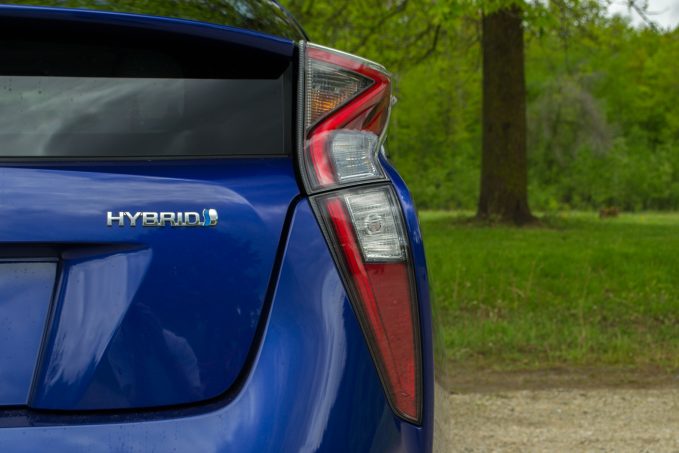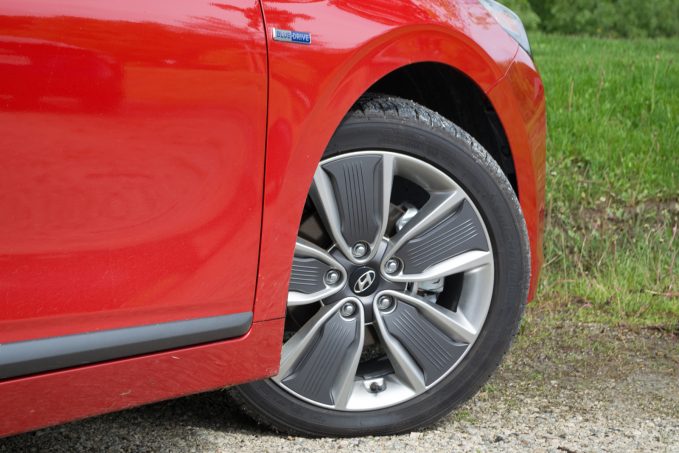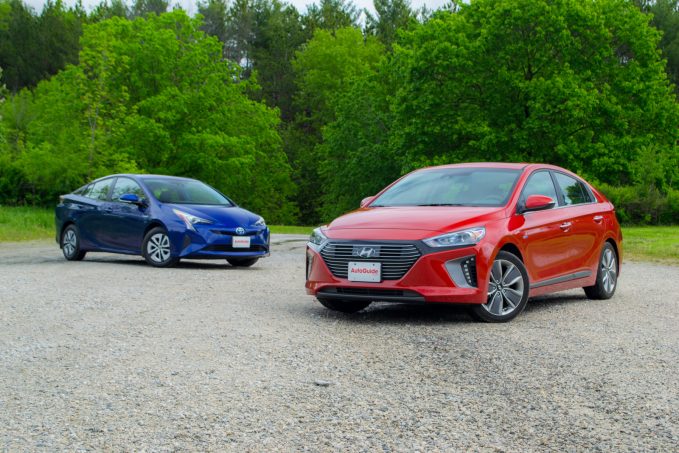In literature, every great protagonist has its foil; a character that helps highlight some of the central figure’s finer qualities.
The Toyota Prius has had many such contrasting characters during its nearly two decades on the market, with the efforts of others simply shining a more positive light on the car that has come to define what a hybrid should be. Except on rare occasions, a foil has the makings of a protagonist waiting in the wings, ready to swoop in and steal the spotlight. The 2017 Hyundai Ioniq could be one such foil.
A Classic Character
Driving the 2017 Toyota Prius, it’s plain to see that this latest version is the best one yet. Riding on a new global architecture that will form the basis for practically everything Toyota produces moving forward, the Prius is surprisingly sharp and nimble. The ride has been dialed in nicely this time around, with a smooth suspension setup that soaks up bumps before they reach the cabin. Likewise, the steering rack has been refined and actually provides a degree of feel and feedback despite being electrically assisted.
Nearly 20 years of building gas-electric vehicles has resulted in a hybrid powertrain that’s practically perfect in execution. A highly thermal-efficient 1.8-liter four-cylinder engine that operates on the Atkinson cycle resides under the hood, with a small electric motor strapped to the side and a continuously-variable transmission (CVT) sending power to the front wheels — a model hybrid setup from the model hybrid car.
ALSO SEE: 2017 Toyota Prius Prime Review
Output isn’t exactly abundant, with a combined 121 horsepower on tap, but it’s enough to keep the Prius rolling along at highway speeds without leaving the car lagging behind everything else on the road. But best of all, the powertrain switches between its gasoline and electric energy sources effortlessly and uneventfully, with the gas engine only noticeable with the skinny pedal pressed to the floor. That, however, can be changed through the Prius’ selectable drive modes, which adjusts throttle response to be more or less economical. As expected, Eco mode dials back throttle response most significantly, while Power mode amps it up, sacrificing fuel economy in the process.
When all the Prius’ power isn’t going to the wheels, it can be diverted to a battery pack mounted beneath the back seat. Base versions of the car get a dated-though-effective nickel-metal hydride battery, while the rest of the lineup comes fitted with a modern lithium-ion unit. Unlike the plug-in version, dubbed the Prius Prime, the standard hybrid model’s battery can only be charged while on the move, though stints of all-electric driving are possible under light throttle load.
Gradual acceleration from a standing start, for example, proved the easiest way to achieve emissions-free driving during our testing, with the gas engine only kicking in at speeds faster than about 31 mph (50 km/h). With some conscious effort to accelerate smoothly — albeit slowly — our tester finished the week averaging 57 mpg (4.1 L/100 km), better than the advertised 52 mpg (4.5 L/100 km) combined average.
Following in Toyota’s Footsteps
Unsurprisingly, the Hyundai Ioniq Hybrid sports a very similar powertrain to the Prius’. With 1.6 liters of displacement, the gas engine is slightly smaller though it, too, minimizes efficiency losses thanks to the Atkinson cycle. The electric motor, meanwhile, makes less power on its own than the one in the Prius, though net system output stands slightly higher at 139 horsepower. Sending that power to the pavement is a six-speed automatic transmission, making it unique amongst hybrids as one of the only multi-geared transmissions available in a gas-electric commuter car.
ALSO SEE: Hypermiling in a Hybrid Gets the Competitive Juices Flowing
That it uses a proper gearbox instead of a continuously-variable one goes a long way in giving the Ioniq the feel of a conventional gas-powered car. In fact, it drives a bit like the Hyundai Elantra, albeit a heavier and slower one. That doesn’t, however, mean the Ioniq drives exactly like a conventional car, and still sports much of that familiar hybrid feel. Throttle response, for example, can feel as though the gas pedal isn’t connected to the powertrain, particularly when switching between the gas and electric motors.
Compare Specs
Much like the Prius, the Ioniq’s blend of electron and petrol power is served smoothly, though it relies on a bit more throttle input in normal conditions to get rolling at reasonable speeds. The Ioniq also boasts a Sport driving mode that improves responsiveness but burns more fuel in the process. Sticking to a far more consumption-conscious driving style netted our tester 59 mpg (4 L/100 km) combined, better than its advertised average of 55 mpg (4.4 L/100 km).
Another similarity the two hybrids share is their somewhat rubbery regenerative brakes, which certainly don’t feel as grabby as others on the market. With proper modulation, however, both systems can be relied upon to top up their batteries on the fly.
The Ioniq also boasts a similarly taut chassis to the Prius’ that provides a little bit of liveliness when called on. While the steering setup is fairly nimble, it’s not overly communicative, though the suspension is stiff enough to verge on sporty while easily absorbing bumps in the road.
Cut From the Same Cloth
Park the Prius and Ioniq side by side and it quickly becomes obvious that they’re cut from same cloth. On that front, however, the Prius takes things farther — and perhaps a bit too far. What’s best described as its stylistic weirdness has been amped up considerably compared to the last version, with the fourth-gen Prius certainly standing out from the crowd. The design language has been the subject of its fair share of criticism since the car was launched, a trend that’s only likely to continue.
By contrast, the Ioniq’s fall from the proverbial ugly tree was from a much lower branch. Its shape is similarly aimed at enhanced aerodynamics, though it’s far more understated than that of the Prius and is passable as simply odd rather than completely outlandish.
The aesthetics of the two cars differ even more greatly inside, with the Prius packing its fair share of oddities. While the interior design is unique it features heavy doses of plastic, including console panels that look like they’re made from recycled toilet seats. It also features a shifted display screen that puts all relevant drive-related information, including the car’s awesome efficiency coaches, in an awkward spot for drivers to see. It’s time to put a traditional gauge cluster in the Prius, Toyota.
For those willing to splurge, a head-up display is available in the Prius, as well as just about every other option imaginable. Items like wireless phone charging and whole host of advanced safety features including adaptive cruise control can be added for a price. Unfortunately, no matter how high up the trip ladder the Prius climbs, it can’t be equipped with real leather seats. In its place is Toyota’s SofTex synthetic that feels downright awful to the touch.
ALSO SEE: 2017 Kia Niro Review
In terms of how much space these two pack, there’s little that sets them apart. Both take full advantage of their identical 106.3-inch (2,700-millimeter) wheelbases to pack a comfortable amount of passenger room in both rows of seats. The Prius boasts slightly more headroom in both rows, with the Ioniq trailing substantially when fitted with its available sunroof. It does, however, offer a little more cargo room, with 26.5 cu-ft (750 liters) compared to 24.6 cu-ft (697 liters) offered in the Toyota. While not exactly noticeable in everyday situations, the extra room would certainly come in handy on a road trip or Costco run.
The Ioniq’s interior also features a far more traditional aesthetic, with little on hand to indicate that it’s partially electrified. The cabin layout is simple, clean and familiar, and doesn’t feel much different than the gas-powered Elantra’s, while the available leather upholstery is far more substantial than the stuff used in Prius. The Ioniq also features some efficiency coaches inside aimed at improving the car’s fuel economy, and while they aren’t as robust and plentiful as the ones in the Prius, they certainly help.
Like the Prius, the Ioniq can be decked out with almost every feature imaginable, including an adaptive cruise control system that, while effective, isn’t quite as smooth as the Toyota’s. Available convenience features include wireless phone charging and, unlike the Prius, Apple CarPlay and Android Auto interfaces that integrate a smartphone’s key features into the touchscreen infotainment system.
The Verdict: 2017 Toyota Prius vs Hyundai Ioniq Hybrid
But the Ioniq’s biggest advantage over the Prius is its price. The entry-level — and most efficient — version starts at $23,035 ($26,004 in Canada) including destination charges, less than the Prius’ MSRP of $24,360 ($28,880 in Canada). The price gap grows somewhat in both cars’ top trims, with the Hyundai coming in at $31,335 ($31,454 in Canada) compared to $34,145 ($34,190 in Canada) for the Toyota.
The Ioniq probably isn’t going to pry many Prius fans out of their favorite Toyota, and that’s understandable. The Prius has a cult-like following for some pretty good reasons, and they’ve only gotten better in this latest version. The Ioniq, however, has what it takes to match the segment-defining Prius stride-for-stride, but best of all it’s cheaper and a little easier to live with, too. And in a segment where it’s all about savings, this foil is ready to steal the spotlight from a longtime protagonist.











